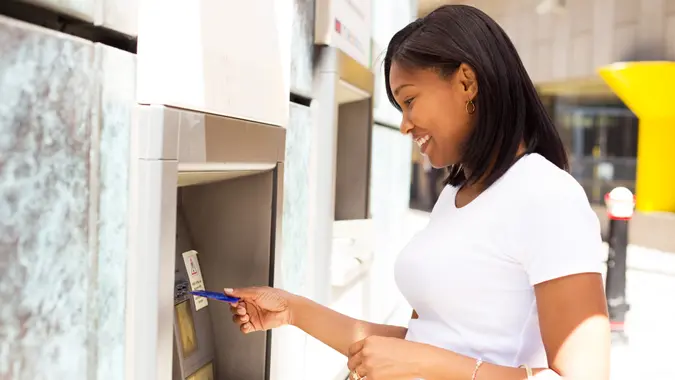4 Big Benefits of Community Banks

Commitment to Our Readers
GOBankingRates' editorial team is committed to bringing you unbiased reviews and information. We use data-driven methodologies to evaluate financial products and services - our reviews and ratings are not influenced by advertisers. You can read more about our editorial guidelines and our products and services review methodology.

20 Years
Helping You Live Richer

Reviewed
by Experts

Trusted by
Millions of Readers
Much like your local bar, when it comes to banking, you often want to go where somebody knows your name. Community banks offer more personalized attention when it comes to overall banking experience, services and products. Big banks may have much of the market cornered, but often banking within your community has plenty of perks.
Community Banks: Quick Take
Community or local banks operate by getting most of their core deposits from within the community they serve. They often prioritize primarily providing traditional banking services as well as reinvesting money locally. Whether for small business loans for local businesses or finding a branch location near you, when you deal with a local community bank, transactions are relationship based.
Pros of Community Banks
- Lower fees than national banks
- Better chance for local small business loans
Cons of Community Banks
- Fewer online banking options
- Not as many products or services as big bank competitors
4 Best Benefits of Community Banking
The benefits of banking locally aren’t just based on convenient geographical locations, but also it is good to know how small banks stack up against larger banks. If you are a small business owner or just want to exercise some hometown pride, consider these reasons to bank within your community.
- Commitment to serving the community
- Personalized service and attention
- Investing your money locally
- Build a banking relationship
1. Commitment To Serving the Community
As these neighborhood banks are part of the community they serve, serving the community seems to happen organically. Whether it is charitable donations to local causes or organizations or even just volunteering for events or other local community services, the team members of a community bank are doubly invested.
2. Personalized Service and Attention
Community banks are often owned, managed and staffed by people who live near the location and are already engrained within the community. If your neighbor or friend works at the bank, it automatically makes your banking experience feel more personalized, and you get more attention on the details of what you and your accounts need.
It also helps to have personal contact with your bank when something happens that you need eyes on quickly from someone who cares.
3. Investing Your Money Locally
Not only do you invest your money locally and conveniently when you use a neighborhood bank, but this also allows that bank to thrive and reinvest money back into your community. This ensures that more local businesses will get loans, allowing more members of the community to pursue their passions and help grow their hometown.
4. Build a Banking Relationship
Relationship banking allows you to be more than just your data on a piece of paper. When the people you bank with know you, that can factor in — instead of just basing loans or other investments on just your credit score, FICO score or payment and credit history.
Although these things will still be considered, your banker knowing you as a person also plays a part in creating a more well-rounded picture of your accountability and finances.
Final Take
Though there are drawbacks to using a community bank, for traditional banking needs, the benefits do seem to outweigh them. So much of business and banking is relationship based, so why not give yourself a leg up on your next financial adventure?
It may be worth having at least one account in your local neighborhood bank to help not only invest in yourself but also back into your community.
FAQ
Here are answers to frequently asked questions about community banks.- Are community banks local banks?
- A community bank, also referred to as a local bank, operates by getting most of its core deposits from within the community it serves. It often focuses primarily on providing traditional banking services and reinvesting money locally.
- Note that just having a local branch does not make a national bank a community or local bank.
- What are examples of community banks near me?
- Many community banks near you can be found through the Independent Community Bankers of America website, which helps you navigate what community banks are in your neighborhood and gives you data on each bank.
- What qualifies a bank as a community bank?
- A bank typically qualifies as a community bank when it operates by getting most of its core deposits from within the community it serves. It focuses primarily on providing traditional banking services and reinvesting money into the community.
- What are the disadvantages of a community bank?
- Here are some common disadvantages of a community bank:
- – They generally have fewer branches or ATM locations.
- – They may not have online, digital or mobile banking options.
- – They won't offer as many products and services as larger national banks.
- Here are some common disadvantages of a community bank:
 Written by
Written by  Edited by
Edited by 
























